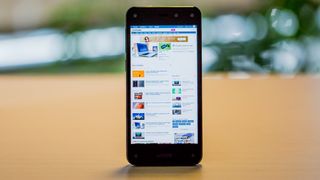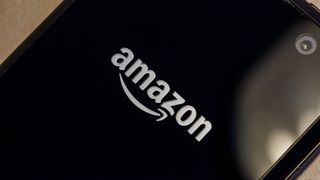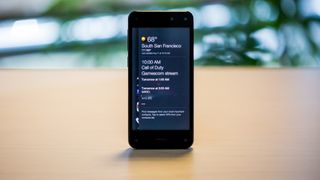TechRadar Verdict
The Fire Phone is a shopping tool for Amazon with some phone features baked in
Pros
- +
Easy Amazon shopping
- +
Decent battery life
- +
24/7 live tech support
Cons
- -
Unintuitive UI
- -
720p display
- -
Expensive
Why you can trust TechRadar
Update: Amazon Fire Phone, last year's biggest smartphone flop, is now available unlocked and with a price drop in the US and UK. That hasn't change our review stance.
Jumping into a highly competitive space, like the smartphone market, is risky. But if there's a company out there that could do it with a chance of success, it's Amazon. Its Fire Phone is the company's first stab at it, and we're going to find out how well it fares against the competition.
In order to have any measure of success, Amazon has to differentiate its smartphone from everyone else, namely Android and iOS 8 smartphones.
There have been rumors of an Amazon smartphone for years, but because of the insane success of Android smartphones from Samsung, HTC and LG, the Amazon smartphone hype never reached the heights that future iPhone iterations would.
Of course, Amazon is no stranger to the mobile device market. Aside from the Amazon apps and Kindle apps, Amazon also has the Kindle Fire HDX, which succeeded the Kindle Fire HD and Kindle Fire.

It's important to note its tablet efforts, because many of the features found on Amazon's tablets are also on the Fire Phone. However, the Fire Phone is loaded with things you won't find on Amazon's tablets, so it's not just a shrunken version of the Kindle Fire HDX.
It's also important to consider the Amazon phone's initial price and current availability. It cost $199 (about £130, AU$245) for the 16GB model that Amazon itself admitted to poorly pricing. Now it's free in the US and UK on-contract, but still through one exclusive carrier in each region, AT&T and O2. There's also an new GSM unlocked version as of November at its original $199.
So, how does Amazon's phone stack up to today's smartphone market? Does it hold its own, or is it just another vehicle for Amazon to sell you more of its products and services? Or does it fall somewhere in between? And will the fact that it's only available on AT&T in the US and O2 in the UK hurt it?
Although another Amazon phone is on its way eventually, there's unlikely to be an Amazon Fire Phone 2 for more than a year, so let's focus on the smartphone we have in hand.
Hardware
The Fire Phone reminds me very much of the Nexus 4 due to its glass front and back, and its soft plastic edges. It feels like a nice device, but it certainly doesn't have the same high-end, premium feel of the HTC One M8 or iPhone 6, for example.
The display measures 4.7 inches with a resolution of 1280 x 720. While it's nowhere near the resolution or pixel density of displays we're seeing today - the LG G3 comes in at a whopping 2560 x 1440 - it's not terrible. It's just not that great.

You'll have 32GB and 64GB memory options for the Fire Phone, with 2GB RAM all powered by a Snapdragon 800 chipset and 2.2GHz CPU and Adreno 330 GPU. Again, not the highest end hardware available on the market, a little old, but just about sufficient. It's the older Lumia way of doing things.

Around the phone, you'll find a power button at top, volume keys and camera button on the left side, and a microUSB port at the bottom.
The back is layered with glass, emblazoned with the Amazon logo, along with a 13MP camera and an LED flash. The camera up front is a 2.1MP shooter, and both cameras are capable of recording 1080p video at 30FPS.
There are also cameras on each corner of the phone that enable Dynamic Perspective, a software feature that gives the display a 3D effect when you tilt the phone.

If you're interested in the exact dimensions of the device, it measures 139.2 x 66.5 x 8.9 mm. It's not the slimmest or leanest device, but it's not bulky, either. And at 160g, it's a nice balance between heft and lightness. I don't like phones that are paper light, nor do I like them brick heavy.
In comparison to the HTC One M8, iPhone 6 and LG G3, it's hard to call the Amazon Fire Phone a high-end or premium device. In fact, in terms of specs, we could've expected a phone like this back in 2012, and hardly in the second half of 2014.
That's already a strike against the Fire Phone in terms of competing with the best out there, which is exactly what Amazon should be doing if it's going to fight for space where Samsung, HTC, Apple and LG live.
Software
Here's where the real meat and potatoes lie, in Amazon's Fire OS. It's based on Android, but if you've ever seen or used Android before, you'll notice immediately that Fire OS looks and feels nothing like Android.
When you fire up the Amazon Fire Phone, you'll be greeted with a 5-minute tutorial on how to use the phone, along with the key features of the device - namely Firefly and Dynamic Perspective.

It's a nice introduction into using your phone, because as you'll find with the Fire Phone, it's not very intuitive. One example is the lack of a menu button and back button, which are things you'd normally find on an Android device.
For many things you'd want to do or access, you'll have to get used to using gestures. It's frustrating and confusing at first, and it's still a nuisance even when you get used to it. For example, instead of a back button, you have to swipe up on the display from the bottom near the home button. It's not naturally intuitive, and sometimes easy to forget even after doing it so many times.
If you're familiar with the Kindle HDX, or any other Amazon devices using Fire OS, you may feel at home with the Fire Phone. Many elements remain the same, such as the carousel home page where your most recent apps live.

On the home page carousel, your recently used apps will also show contextual or relevant info, such as notifications and message previews. It's nice for at-a-glance information, but if you have snooping eyes nearby it's not so pleasant.
It can also be frustrating to have to flip through so many apps to get to the one you want, and it would be nice if you could get rid of the apps with a quick swipe upward, like the old webOS (remember those days?) or the multitasking feature on iOS 8.
There is a notification panel, like Android and iOS, when you swipe down from the top, although it's a strange animation that takes you there. Rather than seeing the panel drop down, the screen fades into the notification center when you swipe downward.

If you swipe from the left of the display, you'll get a quick list of shortcuts, like for apps, photos, videos and more. Swipe in from the right of the display, and you'll have daily contextual info, like calendar entries and weather.

To access your panel of apps, simply press the home button when you're at the home screen carousel, and a list of app icons will appear.
I'm not here to write a tutorial or instruction manual on how to use the phone and every little feature Amazon decided to include in the Fire Phone. However, I will say that it takes time to get acquainted with the platform and to find everything you need.
Current page: Introduction, hardware and software
Next Page Firefly and Dynamic Perspective
I took the rear-windowless Polestar 4 on a three-day road trip – here’s why ditching the back glass was a good (and bad) idea

This mini PC has a 7-inch display that can apparently run Windows and an AMD Ryzen 9 CPU, but there's even better options to be had

Chinese brand’s $2,000 Ryzen AI Max+ mini PC set to go on sale, with the first unit personally signed by the CEO of AMD











